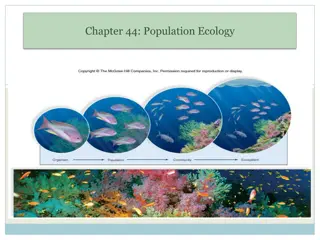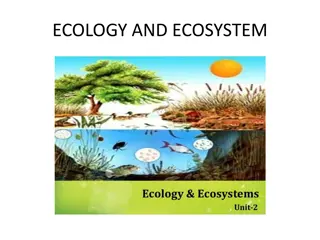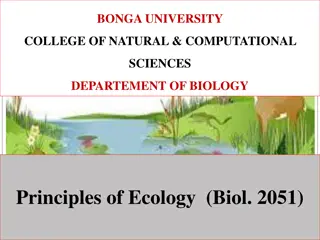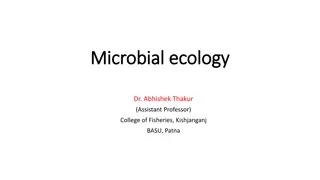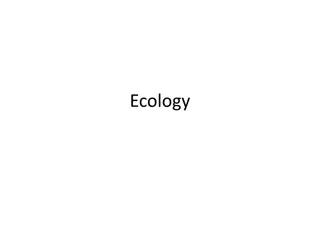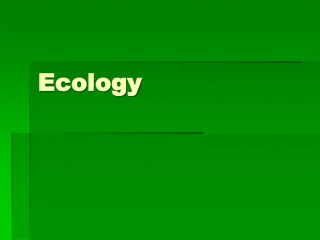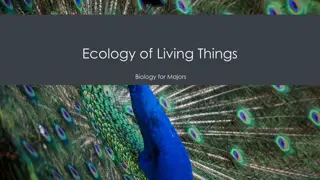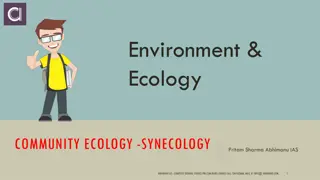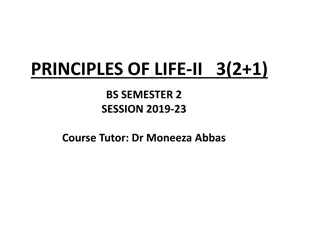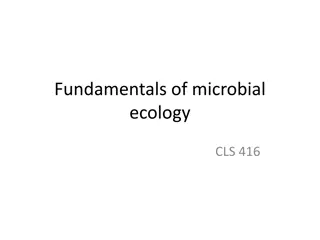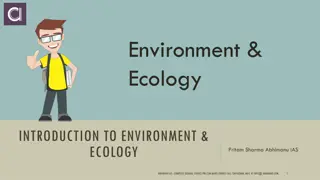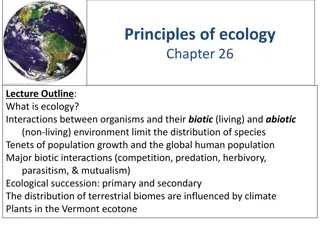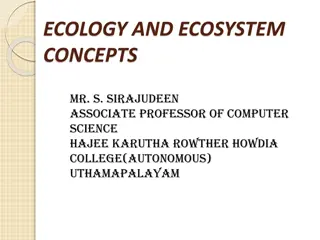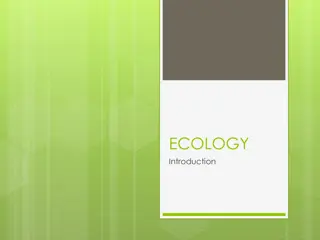Understanding Ecology: Interactions Between Organisms and their Environment
Ecology is the scientific study of how living organisms interact with each other and their environment. It delves into the relationships between biotic and abiotic factors, encompassing topics such as the distribution and abundance of organisms, structural adaptations, behavior under natural conditions, and conservation of natural resources. Ernst Haeckel and Eugenius Warming were key figures in the development of ecological concepts. Ecology comprises various sub-disciplines like Ecophysiology, focusing on how physiological functions influence interactions with the environment.
Download Presentation

Please find below an Image/Link to download the presentation.
The content on the website is provided AS IS for your information and personal use only. It may not be sold, licensed, or shared on other websites without obtaining consent from the author. Download presentation by click this link. If you encounter any issues during the download, it is possible that the publisher has removed the file from their server.
E N D
Presentation Transcript
What is Ecology? Ecology is the scientific study of the interactions between organisms and their environment. It is the science that seeks to describe and explain the relationship between living organisms and their environment.
What is Ecology? (Cont) Ecology is describing the relationships between living organisms and their environment. Ecology comes from the Greek words O kos= House - , -logia= Study of Life Study of the house/environment in which we live.
Factors of Ecology There is two factors that Ecology study: The Abiotic Factors (non-living components) are those inert factors of the ecosystem, as the light, the temperature, the chemical products, the water and the atmosphere. Biotic Factors (living organisms) are all the living beings in an environment.
Ecology is study of interactions between non-living components in the environment light water wind nutrients in soil heat solar radiation atmosphere, etc. AND
Living organisms Plants Animals microorganisms in soil, etc.
Ernst Haeckel, a German zoologist coined the term Ecology in 1866. After that . Danish botanist, Eugenius Warming elaborate the idea of Ecology.
Objective of Ecology The local and geographical distribution and abundance of organisms The inter relationship between organisms in population and community. The structural adaptations and functional adjustments of organisms to their physical environment. The behaviour of organisms under natural conditions. The biological productivity of nature and its relationship with mankind. Temporal changes in the occurrence, abundance and activities of organisms. Conservation and management of natural resources and pollution.
Classification of Ecology Ecology is a broad discipline comprising many sub-disciplines. Under this system the subjects studies: Ecophysiology examines how the physiological functions of organisms influence the way they interact with the environment, both biotic and abiotic. Behavioral ecology examines the roles of behavior in enabling an animal to adapt to its environment.
Classification of Ecology (cont) Population ecology studies the dynamics of populations of a single species. Community ecology (or synecology) focuses on the interactions between species within an ecological community. Ecosystem ecology studies the flows of energy and matter through the biotic and abiotic components of ecosystems.
Classification of Ecology (cont) Systems ecology is an interdisciplinary field focusing on the study, development, and organization of ecological systems from a holistic perspective Landscape ecology examines processes and relationship in a spatially explicit manner, often across multiple ecosystems or very large geographic areas.
Classification of Ecology (cont) Evolutionary ecology studies ecology in a way that explicitly considers the evolutionary histories of species and their interactions. Political ecology connects politics and economy to problems of environmental control and ecological change.
Biosphere Region = Biome Landscape Levels of Ecology Ecosystem Community Population interactions Population Individual
Levels of Ecology Biosphere Surface of the earth It is the whole portion of Earth colonized by living beings
Levels of Ecology (cont) Region Group of ecosystems with the same climate and dominant communities.
Tropical Forest: Vertical stratification with trees in canopy blocking light to bottom strata. Many trees covered by epiphytes (plants that grow on other plants).
Desert: Sparse rainfall (< 30 cm per year), plants and animals adapted for water storage and conservation. Can be either very, very hot, or very cold (e.g. Antarctica)
Coniferous forest: Largest terrestial biome on earth, old growth forests rapidly disappearing, usually receives lots of moisture as rain or snow.
Tundra: Permafrost (Permanent frozen ground), bitter cold, high winds and thus no trees. Has 20% of land surface on earth.
Levels of Ecology (cont) Landscape a group of ecosystems that may or may not interact in a given region
Levels of Ecology (cont) Ecosystem A group of communities and the populations within them embedded in a common physical environment and tied together by physical processes. It refers to all the abiotic factors (physical and chemical constituents) and all the communities that established in a specific area. It is a collection of organisms that live in a place with the nonliving environment.
Levels of Ecology (cont) Community A group of populations of different species occurring in one place; individuals of different species may interact with each other And all the living beings distributed into a specific geographical area. A community includes organisms of different species.
Levels of Ecology (cont) Population A group of individuals of a given species that live in a specific geographic area. A group of organisms, all of the same species, which interbreed and live in the same area. A group of individuals that collectively interact to give birth to new individuals and eventually die
Levels of Ecology (cont) Individual Group of similar organisms that can breed and produce fertile offspring
Ecological Balance: Ecological balance or eco-system stability implies a balance between the production and consumption of each component in the eco system. Theory of Diversity or Stability: If there is diversity of food webs it will lead to an increase in number of links in the food web and if community succession operates in an eco- system, the stability will increase.
Homeostatic Mechanism: Inbuilt, self regulating mechanism is known as homeostatic mechanism. If within an eco system the population of species increases significantly, the result will be scarcity of food, leading to competition for food. Most species will die of starvation and the species population will be brought back to its original value and the stability will be restored.
Ecological instability: When an ecosystem is unable to adjust to the environmental changes, it is said to be unstable. The instability occurs due to a number of natural and anthropogenic activities such as destruction of natural vegetation and animal species, partly or completely or by replacing them by other vegetation and animals, introduction of toxic substances like insecticides and pesticides and toxic gases like SO2, NO2 etc.



















